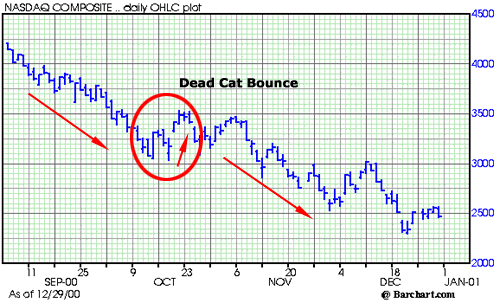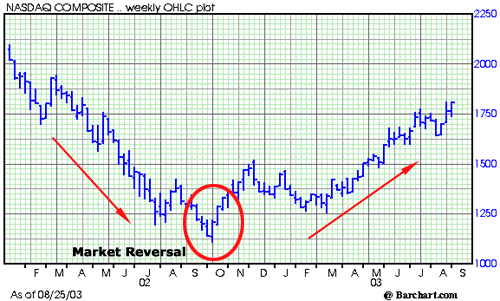
The Dead Cat
Bounce: a Bear in Bull's Clothing?
There's an old
saying in investing that "even a dead cat will bounce if it is dropped from high
enough." The "dead cat bounce" refers to a short-term recovery in a declining
trend. In this article, we explore this phenomenon by looking at an example of a
dead cat bounce and contrasting it to an actual change in sentiment that turns a
market's outlook from bearish to bullish.
What is a
Dead Cat Bounce?
Let's take a look at a period of economic turmoil:

As you can see, the markets took a serious beating during this six-week period in 2000. As gut-wrenching a time as this was, it was not a unique occurrence in financial history. Optimistic periods in the market have always been preceded and followed by pessimistic or bear market conditions, hence the cyclical nature of the economy.
However, a phenomenon unique to certain bear markets, including this one, is the occurrence of a dead cat bounce. After declining for six weeks in a row, the market showed a strong rally. The Nasdaq in particular posted gains of 7.78% after a disappointing string of losses. However, these gains were short lived and the major indices continued their downward march. This chart illustrates just where the cat bounced, how high it bounced, and then how far it continued to fall.

What
Causes a Cat to Bounce?
There comes a time in every bear market when even the most ardent bears rethink
their positions. When a market finishes down for six weeks in a row, it may be a
time when bears are clearing out their short positions to lock in some profits.
Meanwhile, value investors may start to believe the bottom has been reached, so
they nibble on the long side. The final player to enter the picture is the
momentum investor, who looks at his or her indicators and finds oversold
readings. All these factors contribute to an awakening of buying pressure, if
only for a brief time, which sends the market up.
Dead Cat
or Market Reversal?
As we noted earlier, after a long sustained decline, the market can either
undergo a bounce, which is short lived, or enter a new phase in its cycle, in
which case the general direction of the market undergoes a sustained reversal as
a result of changes in market perceptions.
This image illustrates an example of when the overall sentiment of the market changed and the dominant outlook became bullish again.

How can investors determine whether a current upward movement is a dead cat bounce or a market reversal? If we could answer this correctly all the time we'd be able to make a lot of money. The fact is that there is no simple answer to spotting a market bottom. If you want to know more about picking market bottoms (which takes some technical know-how), check out "Market Reversals and How to Spot Them." It is crucial to understand that a dead cat bounce can affect investors in very different ways, depending on their investment style.
Style and
Bouncing
A dead cat bounce is not necessarily a bad thing; it really depends on your
perspective. For example, you won't hear any complaints from day traders, who
look at the market from minute to minute and love volatility. Given their
investment style, a dead cat bounce can be a great money making opportunity for
these traders. But this style of trading takes a great deal of dedication, skill
in reacting to short-term movements, and risk tolerance.
At the other end of the spectrum, long-term investors may become sick to their stomachs when they bear more losses just after they thought the worst was finally over. If you are a long-term, buy-and-hold investor, following these two principles should provide some solace:
Conclusion
Downward markets aren't fun at the best of times, and when the market toys with
your emotions by teasing you with short lived gains after huge losses, you can
feel pushed to the limit. If you are a trader, the key is to figure out the
difference between a dead cat bounce and a bottom. If you are a long-term
investor, the key is to diversify your portfolio and think long-term.
Unfortunately, there are no easy answers here, but hopefully this article helped
you what a dead cat bounce it, and how it effects different participants in the
market.